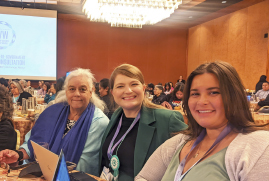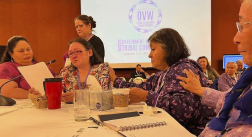17th Annual Tribal Consultation On Violence Against Women

Photo courtesy of Kelsey Foote.
Priority Issues to Address Violence Against Indian Women
The following issues, concerns, and recommendations were identified by Tribal Nations and advocates during past annual consultations (2006 – 2021), through National Congress of American Indians (NCAI) resolutions (2000 – 2021), through regional Tribal organization resolutions, at numerous national meetings, and Congressional hearings and Hill briefings. Tribal leaders and advocates continue to raise concerns about barriers preventing the protection of American Indian and Alaska Native (AI/AN) women at numerous national meetings with the administration, federal departments, and agencies, with their respective Congressional delegations, and in NIWRC’s VAWA Sovereignty Initiative’s amicus briefs. A review of statements made by Tribal leaders during consultations since 2006 as well as before other state and federal policymakers demonstrates that many of the issues raised are not new, but instead illustrate the complicated legal and policy barriers embedded in the layers of federal Indian law. These issues are monitored on an ongoing basis and compiled by the NCAI Task Force on Violence Against Women.
The concerns and recommendations raised by Tribal Nations are extensive, as documented in oral and written testimonies of Tribal Nations and past VAW Consultation Reports to Congress. The following pages discuss some of the priority issues. Additional issues are discussed in articles concerning Alaska Natives, the Family Violence Prevention Services Act Consultation, the Centering Prevention of Missing and Murdered Indigenous Women, and STTARS HUD Consultation Guidance articles.
Issues Regarding Implementation of the Violence Against Women Act (VAWA)
- Tribal Jurisdiction Over Non-Indian Offenders and Special Tribal Criminal Jurisdiction (STCJ). Limited Tribal jurisdiction over non-Indian offenders on Tribal lands continues to be a key reason for the perpetuation of disproportionate violence against AI/AN women. The 2013 reauthorization of VAWA addressed this issue for certain crimes of domestic violence, dating violence, and certain protection order violations for some Tribal Nations. The 2022 VAWA reauthorization expanded the list of covered crimes to include sexual assault, stalking, sex trafficking, child violence, obstruction of justice, and assault against justice personnel. VAWA 2022 restored jurisdiction to Tribes in Maine and established an Alaska Pilot Project. While a pivotal step forward, the most recent reauthorization did not address protections for elders or serious crimes that co-occur with domestic and sexual violence, such as financial crimes and homicide. Perpetrators will continue to slip through the cracks until Congress fully restores every Tribal Nation’s complete jurisdiction over non-Indians.
- Funding and resources are a significant problem for Tribal Nations in implementing their restored jurisdiction under VAWA. Tribal Nations spend significant amounts of time and resources to prepare their justice systems and victim services to meet the needs of their communities. However, many Tribal Nations are limited by a lack of holistic, consistent, and sustainable funding for their justice systems, leaving many with restored jurisdiction but without the resources to implement VAWA. When asserting this restored jurisdiction, Tribal Nations are also confronted with costly healthcare expenses for non-Indian inmates sentenced by Tribal courts, often straining their limited budgets. The 2022 VAWA Tribal reimbursement program will help with many of these costs, but additional, consistent, and sustainable upfront funding for holistic Tribal justice systems and victim services must be appropriated by Congress for Tribal Nations to build capacity and utilize the new reimbursement program.
Recommendations for the Department of Justice (DOJ) and the Department of Interior (DOI):
- DOJ and DOI should coordinate and work together to implement the provisions of VAWA 2022 and support Tribal Nations in implementing their restored jurisdiction over non-Indian perpetrators. We recommend the following next steps for DOJ and DOI regarding implementation and Tribal support:
- DOJ and DOI should offer joint training opportunities for Tribal Nation law enforcement and federal law enforcement on implementing VAWA 2022 in Indian Country. What resources do DOJ and DOI have for Tribal law enforcement training, and will those resources be expanded to cover the Alaska Pilot Program? Finally, will the National Indian Country Training Initiative include new training regarding all VAWA 2022 provisions, including the Alaska provisions?
- DOJ and DOI need to be on the same page regarding Alaska Native Villages’ restored jurisdiction under the Bureau of the Census Tribal Statistical Areas. Tribal and federal staff will need training on this new area of restored jurisdiction. The Bureau of Indian Affairs (“BIA”) seems to be confused about Alaska Native Villages’ land status and their legal authority with the designation of the Village Census Area. How will DOI and BIA address this confusion and ensure a consistent understanding with DOJ
- DOJ and BIA should build on the June 2019 DOJ law enforcement emergency, which led to additional justice resources for the area; however, the majority of the funding never reached Alaska Native Villages. The DOJ should build on that declaration and work with the DOI to provide comprehensive justice and public safety funding directly to Alaska Native Villages rather than the state of Alaska.
- Ensure that the STCJ grant program and the STCJ reimbursement program are easy for Tribal Nations to apply for and fulfill reporting requirements to the appropriate agency. Additionally, the programs should be improved to be culturally responsive to the needs of Tribal Nations and not locked into a rigid list of allowable costs or requirements. VAWA 2022 notes that the reimbursable expenses shall include “costs incurred in, relating to, or associated with” the four designated reimbursement areas. This flexible language allows DOJ to be much more expansive than only the four designated areas in the law. For example, there are dire infrastructure needs across Indian Country, and Nations cannot prosecute perpetrators if they do not have roads to drive on or courthouses for trials. We urge the DOJ to include this flexibility in their reimbursement regulations. DOJ should also consider the recommendations Tribal leaders presented during the various consultations on the Tribal reimbursement program.
- In the President’s Budget, the DOJ should request the full amount of funding authorized for Tribal programs in VAWA 2022, especially the $25 million for the STCJ grant program and reimbursement for FY 2024 and FY 2025.
- In their appropriations request, the DOJ and DOI should request annual, consistent, and sustainable noncompetitive funding for Tribal Nations to build the capacity of their entire justice systems and victim services.
- DOJ and DOI should fund the Alaska Pilot Project sufficiently and make building infrastructure allowable for all Alaska Native Villages interested in exercising STCJ. The Bureau of Prisons (BOP) should overhaul its Tribal prisoner program to make it easier for Tribal Nations to submit inmate placement requests and ensure that they have BOP staff on hand to respond to Tribal Nation inquiries. Additionally, BOP should cover transportation costs for Tribal Nations to transport inmates to designated facilities or coordinate with Tribal Nations to provide federal transportation to the facility.
- DOJ and DOI should support legislation that would fully restore Tribal Nations’ jurisdiction over all non-Indians for any offense.
- The DOJ and DOI should support legislation removing the limited number of Tribal Nations eligible to exercise restored jurisdiction under the Alaska Pilot Project.
- Increase funding for Tribal Nation implementation of STCJ for DOJ, HHS, and the BIA.
Issues Regarding Bureau of Indian Affairs (BIA), DOI Disparities in Funding
Sixty-five percent of all federally recognized Indian Tribes are located in P.L. 280 states. Certain P.L 280 states fail to investigate and prosecute crimes involving violence against AI/AN women. Exacerbating this lack of state justice responses, the BIA and DOI have failed to fulfill the federal trust responsibility to Tribal Nations located in P.L. 280 states providing zero to little support for Tribal law enforcement and Tribal courts in these states. Consequently, the Tribal Nations in P.L. 280 states are caught between two systems: they have fewer resources to develop their Tribal justice systems, including police departments and court systems, and states that have concurrent jurisdiction fail to fulfill their responsibilities under the law. The DOJ has financially supported and provided technical assistance to Tribal Nations for developing and enhancing their Tribal police departments and Tribal court systems since the 1990s. Only in the past few years has the DOI requested and received funding towards this end due to Tribal Nations’ outcry on this issue. The federal funding disparities for Tribal Nations located in P.L. 280 states and similarly situated jurisdictions must be addressed more robustly and immediately by the federal government.

Photo courtesy of Tasha Paukan.
Recently, the BIA and DOI submitted a report to Congress estimating that to provide a reasonable base level of funding to all federally recognized Tribes: $1 billion is needed for Tribal law enforcement, $1 billion is needed for Tribal courts, and $222.8 million is needed for detention. Based on recent appropriation levels, the BIA generally funds Tribal law enforcement at about 20 percent of the estimated need, Tribal detention at about 40 percent of the estimated need, and Tribal courts at a dismal 3 percent of the estimated need. In P.L. 280 states, Tribal Nations have virtually no BIA law enforcement presence or funding for courts and law enforcement other than what is appropriated from year to year, essentially providing no sustainability or safety. It is imperative not only to fully restore Tribal Nations’ jurisdiction over non-Indian perpetrators but to also provide funding for their justice systems so that they can make Indian Country safer for everyone that lives there.
Photo courtesy of Tasha Paukan.
Recommendations for BIA and DOI:
- BIA and DOI should continue to request appropriate additional federal funding to provide public safety and justice resources to Tribal Nations located in P.L. 280 states.
- BIA and DOI should provide funding to Tribal Nations located in the P.L. 280 states for their Tribal court systems and law enforcement agencies and administer that funding in a sustainable and equitable manner while ensuring accountability.
- BIA and DOI should seek to end the disparity in funding between Tribal Nations based on their location within or outside of a P.L. 280 state.





